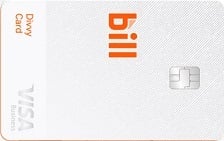Filter Options
×-
-
Unselect all
-
Unselect all
-
Unselect all

Showing 11 Cards
Sort By Column Name:
Ink Business Premier® Credit Card

Ink Business Premier® Credit Card
- Flex for Business variable APR: 18.74% to 26.74% Regular Purchase APR
At a Glance
The Chase Ink Business Premier Credit Card is a premium business card that earns up to 2.5% cash back on purchases of $5,000+ and 2% back on all other purchases. The card operates either as pay-in-full, or pay-over-time, thanks to Flex for Business.
- Best Benefits
- Rates & Fees
- Why Should You Apply?
- Earn $1,000 bonus cash back after you spend $10,000 on purchases in the first 3 months from account opening.
- Earn unlimited 2.5% total cash back on purchases of $5,000 or more and unlimited 2% cash back on all other business purchases.
- Travel Benefits: Unlimited 5% total cash back on travel purchased through Chase Travel℠, No Foreign Transaction Fees and Trip Cancellation/Trip Interruption Insurance.
- The only business credit card with 2.5% cash back on every purchase of $5,000 or more.
- Get the buying power you need to make large purchases, cover monthly expenses and help your business grow. While you must pay your Pay In Full balance each month, this card has built-in flexibility. The Flex for Business feature allows for qualifying purchases to be paid over time with interest.
- Purchase with confidence with built-in protections like Fraud Protection, Zero Liability Protection, Purchase Protection, Cell Phone Protection, and Extended Warranty Protection.
- There's no additional cost for employee cards. Monitor spend with digital tools like purchase alerts, set spending limits, reporting, and more.
- Member FDIC
- Regular Purchase APR: Flex for Business variable APR: 18.74% to 26.74%
- Annual Fee: $195
- Late Payment Penalty Fee: $40 or 2% of the Minimum Payment Due, whichever is greater
- You own a medium-sized business with cash reserves
- You make frequent large purchases of $5,000 or more
- You want to earn cash back from your business expenses
- You manage employees who will use their own issued cards
American Express® Business Gold Card
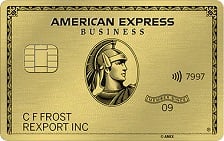
American Express® Business Gold Card
- 19.49% to 27.49% variable based on creditworthiness and the Prime Rate for Pay Over Time Regular Purchase APR
At a Glance
Business owners with a clear understanding of their company’s needs will enjoy the customizable rewards available to them through the American Express® Business Gold Card. The card gives you the ability to choose two categories to receive 4X the points from, then one point per dollar spent on all other eligible purchases plus a generous welcome offer where companies can earn 100,000 Membership Rewards points.
- Best Benefits
- Rates & Fees
- Why Should You Apply?
- Welcome Offer: Earn 60,000 Membership Rewards® points after you spend $6,000 on eligible purchases with the Business Gold Card within the first 3 months of Card Membership*
- **4X points apply to the first $150,000 in combined purchases from these 2 categories each calendar year.*
- PAY OVER TIME OPTION: Decide whether you want to pay eligible purchases in full each month – or pay over time with interest.*
- *Terms Apply.
- Regular Purchase APR: 19.49% to 27.49% variable based on creditworthiness and the Prime Rate for Pay Over Time
- Penalty APR: 29.99% variable based on the Prime Rate
- Annual Fee: $295
- Late Payment Penalty Fee: $39 or 2.99% of any past due Pay in Full amount, whichever is greater
- Return Payment Penalty Fee: $39
- You own a business and want to earn points for everyday expenses on select bonus categories where your business spends the most, such as airfare, advertising, gas, shipping, and computers
- You plan to make frequent purchases, particularly within the first few months of becoming a cardholder, in order to qualify for lucrative introductory offers
- You can benefit from insightful software tools to both help manage your business and recruit promising talent
- You will make use of Amex’s Pay Over Time option for business expenses
The Business Platinum Card® from American Express
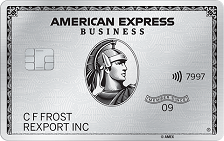
The Business Platinum Card® from American Express
- See Terms Regular Purchase APR
At a Glance
Companies can expect the pinnacle of luxury when they use The Business Platinum Card® from American Express. This exclusive metal rewards card provides premium travel rewards, a huge welcome offer, and a variety of other perks for the savvy business traveler.
- Best Benefits
- Rates & Fees
- Why Should You Apply?
- Welcome Offer: Earn 130,000 Membership Rewards® points after you spend $15,000 on eligible purchases with your Card within the first 3 months of Card Membership
- Get 5X Membership Rewards® points on flights and prepaid hotels on amextravel.com, and 1X points for each dollar you spend on eligible purchases
- Earn 1.5X points (that's an extra half point per dollar) on eligible purchases at US construction material & hardware suppliers, electronic goods retailers and software & cloud system providers, and shipping providers, as well as on purchases of $5,000 or more everywhere else, on up to $2 million of these purchases per calendar year
- Unlock over $1,000 in value per year for statement credits on select purchases, including tech, recruiting and wireless with the Business Platinum Card
- $200 Airline Fee Credit: Select one qualifying airline and then receive up to $200 in statement credits per calendar year when incidental fees are charged by the airline to your Card or any of the Additional Cards on your Platinum Card account
- $189 CLEAR® Credit: CLEAR® uses biometrics to assign you a touchless ID, allowing you to move faster through security at select airports and stadiums across the U.S. You can cover the cost of a CLEAR membership with up to $189 in statement credits per calendar year after you pay for CLEAR with your Business Platinum Card®
- The American Express Global Lounge Collection® can provide an escape at the airport. With more than 1,400 airport lounges across 140 countries and counting, you have more lounge location options than any other credit card on the market as of 9/2021
- $695 Annual Fee
- Terms Apply
- Regular Purchase APR: See Terms
- Penalty APR: 29.99% variable based on the Prime Rate
- Annual Fee: $695
- Late Payment Penalty Fee: $39 or 2.99% of any past due Pay in Full amount, whichever is greater
- Return Payment Penalty Fee: $39
- You travel often for work and can take advantage of a myriad of benefits including access to airport lounges
- You will make use of statement credits for Global Entry or TSA Precheck
- You prefer airline flexibility when redeeming your points for travel
The Platinum Card® from American Express
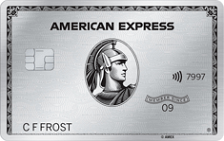
The Platinum Card® from American Express
- See Pay Over Time APR Regular Purchase APR
- 29.99% variable based on the Prime Rate Cash Advance APR
At a Glance
Luxury is always within reach when you use The Platinum Card® from American Express. This exclusive rewards card offers premium travel rewards and a host of additional perks for the savvy voyager. Uber Cash and complimentary lounge access are just a few of the more practical perks that lend ongoing value to Platinum Card members beyond the impressive signup bonus.
- Best Benefits
- Rates & Fees
- Why Should You Apply?
- Earn 5X Membership Rewards® Points for flights booked directly with airlines or with American Express Travel up to $500,000 on these purchases per calendar year and earn 5X Membership Rewards® Points on prepaid hotels booked with American Express Travel
- 5X Membership Rewards® Points on prepaid hotels booked on amextravel.com
- $200 Airline Fee Credit: Get up to $200 in statement credits per calendar year in baggage fees and more at one select qualifying airline
- Get up to $100 in statement credits annually for purchases at Saks Fifth Avenue on your Platinum Card®. That's up to $50 in statement credits semi-annually. Enrollment required
- $200 Hotel Credit: Get $200 back in statement credits each year on prepaid Fine Hotels + Resorts® or The Hotel Collection bookings, which requires a minimum two-night stay, through American Express Travel when you pay with your Platinum Card®
- VIP status and $200 Uber savings on rides or eats orders in the U.S. annually
- Complimentary Gold status in Marriott Bonvoy and Hilton Honors programs
- Complimentary membership in premium car rental programs
- $240 Digital Entertainment Credit: Get up to $20 back each month on eligible purchases made with your Platinum Card® on one or more of the following: Audible, Disney+, The Disney Bundle, ESPN+, Hulu, Peacock, SiriusXM, and The New York Times. Enrollment required.
- $179 CLEAR® Credit: Use your Card and get up to $179 back per year on your CLEAR® membership
- $300 Equinox Credit: Get up to $25 back each month on the Equinox+ digital fitness app, or eligible Equinox club memberships when you pay with your Platinum Card®. Enrollment required
- $155 Walmart+ Credit: Cover the cost of a $12.95 monthly Walmart+ membership with a statement credit after you pay for Walmart+ each month with your Platinum Card. Cost includes $12.95 plus applicable local sales tax
- Terms Apply
- Regular Purchase APR: See Pay Over Time APR
- Cash Advance APR: 29.99% variable based on the Prime Rate
- Cash Advance Transaction Fee: Either $10 or 5% of the amount of each cash advance, whichever is greater
- Penalty APR: See Rates & Fees
- Annual Fee: $695
- Late Payment Penalty Fee: Up to $40
- Return Payment Penalty Fee: Up to $40
- You travel often and can take advantage of a myriad of benefits including access to airport lounges and Uber credits
- you intend to sign up for Global Entry or TSA Pre?®
- You prefer airline flexibility when redeeming points for travel
- You're likely spend $6,000 within the first six months as a cardholder to receive the card’s welcome offer
- You'll take advantage of exclusive events and experiences available only to Platinum cardholders
The Plum Card® from American Express

The Plum Card® from American Express
At a Glance
Business owners searching for a business credit card with flexible payment options will find the Plum Card® from American Express as useful as it is unique. Offering cash back, flexible spending capacity and a 60-day grace period to pay off monthly balances, the Amex Plum Card is a credit option that’s perfect for accommodating new business owners, entrepreneurs, and freelancers with irregular income.
- Best Benefits
- Rates & Fees
- Why Should You Apply?
- Paying early pays off: get a 1.5% Early Pay Discount on your statement on the amount paid within 10 days of your statement closing date and no cap on what you can earn back. Just pay the Minimum Due by the Payment Due Date
- Up to 60 days to pay with no interest
- Choose whether to receive your bill at the beginning, middle, or end of the month
- Annual fee waived the first year
- No preset spending limit
- Employee Plum Cards for no additional fee
- Annual Fee: $250
- Late Payment Penalty Fee: $39 or 1.5% of the past due amount, whichever is greater
- Return Payment Penalty Fee: $39
- You own or operate a business
- You want the option to earn cash back
- You have irregular cash flows and don’t want to be penalized for it
- You don’t want to pay an annual fee for employee cards
You've viewed 5 of 11 credit cards
Charge Cards vs Credit Cards
The phrase “charge card” is often used interchangeably with “credit card.” This is understandable, as the term refers to a card that can hold charges, and credit cards certainly fit that description. However, charge cards technically fit into their own category of payment, with their own advantages and disadvantages.
They function similarly to credit cards when it comes to making purchases, but have a few unique differences when it comes to paying the bill. These deviations may make them better or worse options for certain cardholders.
How Does a Credit Card Work?
Most consumers are familiar with how credit cards work – but not charge cards. First, an issuer reviews a credit card application to determine if the applicant qualifies. If approved, the issuer uses the applicant’s credit history (including their FICO scoring model credit score) to determine the size of their credit line and the interest rate.
Then, the applicant can begin to make purchases using the card. At the end of each month, the issuer provides a statement balance and requests payment. The cardholder has the option to make the required minimum payment, cover the entire balance, or pay somewhere in between.
Any funds leftover on the account will begin to accrue interest – unless it’s a 0% intro APR card. Though a charge card can technically be considered a type of credit card, they operate quite differently in these key aspects:
- Interest and Balances
- Late fees
- Annual fees
- Spending limits
Where to Get a Charge Card
Since charge cards have been largely replaced by credit cards, you won’t find a huge variety. In fact, American Express is the only of the major credit card issuers that currently offers these cards, along with a selection of Amex credit cards. An American Express charge card often comes with an abundance of luxurious travel perks, impressive membership rewards points – and a high annual fee to match.
Perhaps the most famous of the charge cards is the Platinum Card from American Express. There is also the famed Centurion Card, which is only available to VIPs and by invitation (through a high spending threshold of over $250,000 per year or more. At the entry-level, the American Express Green Card is an excellent option, given it’s quality travel rewards and relatively low $95 annual fee.
Do Other Issuers Offer Charge Cards?
While American Express might be the name most commonly associated with charge cards, there are other options available. Many commercial cards are charge cards. These aren’t business credit cards, but they are similar in that they are offered to large corporations. Some of these cards are used for purchasing bulk items for fleets, such as gas charge cards from Conoco.
In terms of consumer charge cards, there aren’t many non-Amex charge cards on the market today. These products tend to be boutique and custom offers from specialized brands and not something the average consumer would hold or use every day.
Some cards for bad credit are actually charge cards and not traditional credit cards. Some examples of charge cards for bad credit include merchandise cards from Horizon Card Services:
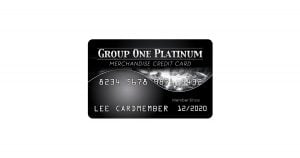 Group One Platinum |
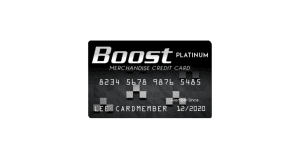 Boost Platinum |
 NetFirst Platinum |
 Freedom Gold |
 Buy On Trust Lending |
 Unique Platinum |
Cards like the Boost Platinum Card offer quick approval, a fast and easy application process, and no credit check. like Horizon or the Group One Platinum, lets consumers build a positive credit history, thanks to regular reporting one of the major credit bureaus: Experian, Equifax, and TransUnion. Even better, there’s no security deposit requirement, as is the case with secured credit cards.
Advantages and Disadvantages of a Charge Card
With how charge cards work, there are plenty of pros and cons to weigh before you decide to get one. For one thing, your card can get very expensive if you have trouble paying your balance in full each month. On the other hand, you’ll never have to worry about credit limits or interest rates if payments aren’t a problem for you. Plus, you can still get access to plenty of worthwhile rewards for your purchases, including travel credits.
Because charge cards have no preset credit limit, they are only for people with excellent credit – or at least a very good credit score. Charge cards are not really a tool to build credit. Rather, a charge card is something like a personal finance payment card for someone with excellent credit to take advantage of and use for their everyday needs.
Editorial Disclosure – The opinions expressed on BestCards.com's reviews, articles, and all other content on or relating to the website are solely those of the content’s author(s). These opinions do not reflect those of any card issuer or financial institution, and editorial content on our site has not been reviewed or approved by these entities unless noted otherwise. Further, BestCards.com lists credit card offers that are frequently updated with information believed to be accurate to the best of our team's knowledge. However, please review the information provided directly by the credit card issuer or related financial institution for full details.


